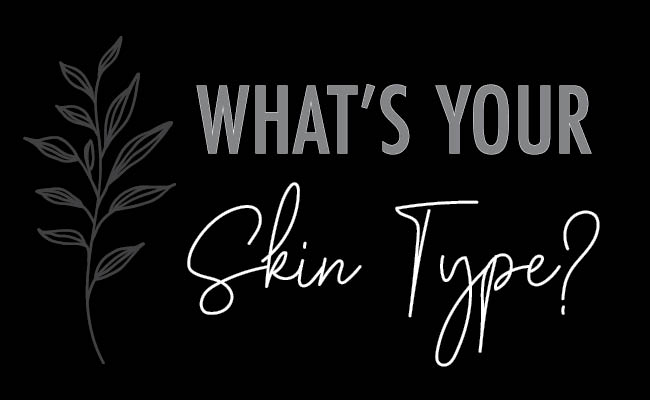
How do you determine which products are best for your skin? There are probably more brands and products than ever before. Although this is a wonderful thing, it can be confusing and difficult to make choices with the overload of options. Determining your skin type is the first step to finding the best products and treatments to alleviate your symptoms.
Do you know your skin type?
The best way to determine your skin type is to wash your face and leave it without products or makeup for two hours. After your two hours is up, read below to evaluate the appearance and feel of your skin!
- Normal Skin: Smooth feeling with no flakes or shiny areas
- Oily Skin: Slick feeling with shiny and greasy touch
- Dry Skin: Dry feeling with flaking and tightening
- Combination Skin: Oily t-zone with dryness in other areas
- Acne-Prone Skin: Bumpy areas with blackheads, pimples or whiteheads
Determining your skin type also helps the estheticians best suggest treatments for you such as facials, peels and products.
Why Does Your Skin Type Change?
There are many environmental and internal influences that can impact your skin’s appearance and texture. Keep in mind while reading this that our skin is constantly changing, there are so many environmental factors that can impact the appearance and touch of your skin. Even though you may know your skin type today, your skin can change seasonally, if not monthly.
- Hormone changes (menopause, pregnancy, menstrual cycles, etc.)
- Skin disorders (Rosacea, Dermatitis, Psoriasis)
- Genetics
- Diet
- Medications
- Climate (temperature and humidity)
- Skin Care (lack of routine, over-exfoliating, over-moisturizing, improper ingredients)
- Sun Damage
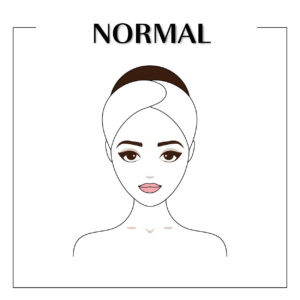 Normal Skin
Normal Skin
Those with normal skin are extremely lucky! There are less issues with this skin type and therefore caring for it is much easier. Precautions should still be made for conditions that develop over time, such as fine lines, wrinkles, or aging/ sun spots. Always, always, always wear sunscreen and develop a skin care routine that cleanses and moisturizers your face day and night. A relaxing and calming facial is always a plus, too!
Check out our Signature Revive Facial that helps evening complexion and plumps the skin! A routine skin care regime can also dramatically improve the texture and prevent fine lines, wrinkles and premature aging. Shop our most popular lines, PCA Skin and Le Mieux to discover flawless skin.
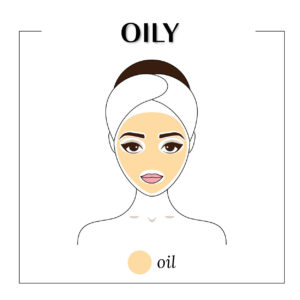 Oily Skin
Oily Skin
With dry skin you produce less sebum than normal, with oily skin type, you produce more than what’s needed. Although sebum is vital for healthy skin, too much not only causes a shiny appearance but it can lead to clogged pores and acne. Oily skin may appear to be glossy and slick at the touch. A secondary skin condition of oily skin is large pores, which also generates MORE sebum. If you have oily skin you should avoid certain moisturizers that can feel heavy or thick. However this does not mean you shouldn’t moisturize!
A few common reasons for oily skin include the weather (hot and humid), high stress, genetics, hormone changes, foundations(s), and lack of a consistent skincare routine. As with every skin type, it’s best to wash regularly and get in to the habit of making your skin a priority.
Clay based masks are great to use on oily skin as well as our Le Mieux GSA25 “Resurface & Degrease” Facial! this facial specifically targets congested pores and excess oil production while treating acne conditions.
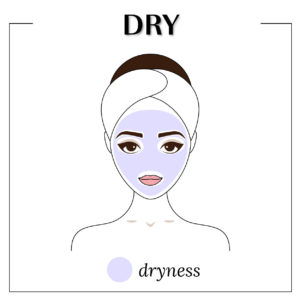 Dry Skin
Dry Skin
Having dry skin means you produce less sebum than normal. Sebum is an oily secretion of the sebaceous glands that help retain moisture and protects your skin against the elements. Dry skin may feel tight and rough, sometimes looking flaky and dull. The dullness is most likely because your outermost layer is composed of dead skin cells. Keep in mind that there IS a difference between dehydrated skin and dry skin. Dehydrated skin means your body is losing more water than it is taking in. Dehydrated skin can cause skin to feel oily and dry at the same time and you may experience breakouts (DRINK YOUR WATER LADIES & GENTS!).
Some common causes of dry skin are:
- Weather: As Alaskans, we know winter months can be rough, especially on our skin. When the humidity and temperature plummets, the environment for our skin changes and therefore the complexity does.
- Soaps/ Detergents: Many soaps, detergents, lotions and other products that go directly on our skin strip moisture from it.
- Heat: As much as we all love to be cozy and have space heaters, this is actually a very common reason for our skin to dry out, due to the heater reducing the humidity in the air.
- Skin Conditions: If you have a skin condition such as eczema, psoriasis, it is best to consult with your dermatologist or primary care provider before trying new products.
- Long Hot Showers/ Baths: Although long showers are soo relaxing, if we have too long of showers, too frequently, it can dry out our skin because the temperature strips away our natural oils.
Try out our 60 minute Hydrating Facial to renew your skin and reveal your hydrated skin. You can also shop for the best products for your skin type, here, Shop By Concern – Dullness. For dry skin, it’s best to use oil/ cream based products. If dry skin isn’t handled properly, it can also lead to premature aging, so it’s best to start caring for your skin sooner rather than later!
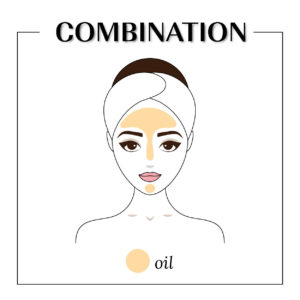 Combination Skin
Combination Skin
Combination skin can mean that you have seasonal skin (oily in summer, dry in winters) or that your t-zone is oily while other areas are dry. Causes for this skin time are most likely genetic but some are environmental, such as the weather, your makeup and skin care routine. With this skin type, you need to carefully choose your products because some may further aggravate your skin. Depending on how severe your areas are, you may need to have separate products for the oily/ dry.
A good water soluble cleanser is generally safe, with a non-irritating toner, a BHA exfoliant, and a nighttime gel or lotion. This clay based mask is great to use in your T-zone and can help with controlling your pores. LAPCOS has a variety of products that are gentle yet effective for combination skin and even an eye/ lip remover!
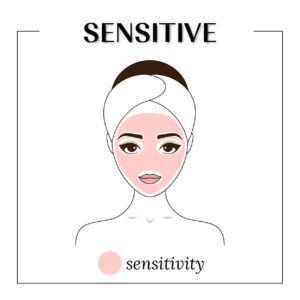 Sensitive Skin
Sensitive Skin
Sensitive skin is identified as skin that is easily irritated. For this skin type, you may not eben know you have sensitive skin until you have a reaction to products, soaps or makeup. Symptoms of sensitive skin are flaking, visible redness, rashes, scaling and roughness. There are so many possible causes of sensitive skin so it’s best to keep track of your reactions and avoid products that may be irritating your skin. Some common causes include UV damage, hormone changes, stress, over exfoliation, allergies, using harsh ingredients, poor diet, not removing your makeup and certain skin conditions (eczema, psoriasis, rosacea etc.).
Why Am I Sensitive?
Those with sensitive skin tend to have a weak skin barrier, a layer that helps protect environmental factors, which is why using quality ingredients to build up your protective layer is essential. Be sure to always use sunscreen, wash your face morning and night, wash with lukewarm water and avoid harsh chemical or over exfoliation.
The PCA Cleanser is amazing for sensitive skin, which pairs perfectly with the Dual Action Redness Relief which improves the skin’s barrier function.
Or try the Sensi Peel, a total life-saver for sensitive skin. If you’re looking for a facial or professional advice on skin care, our estheticians can help you understand products that are safe for your skin.
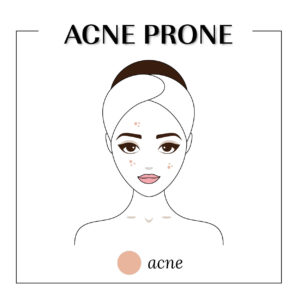 Acne-Prone Skin
Acne-Prone Skin
Earlier we mentioned that acne can be a secondary factor to oily skin. This holds true but you can also have any other skin type and also deal with acne. Some triggers for acne include excess oil (sebum), bacteria, and clogged pores, and dead cells (lack of cell turnover).
To control your acnes and breakouts, ensure that you are cleansing morning and night and freeing your face of excess oil. You’ll also need to remove any surface bacteria and be cautious of washing your hands/ touching your face throughout the day. As a teenager I would constantly sit in class with my palm propping my head up at school. I also breakout on my cheeks and chin and didn’t realize until YEARS later that after touching books all day, door handles, shared pencils, you name it, I was inviting bacteria on to my face! The last thing to tackle is the dead skin cells.. as we age our skin cells turn over less frequently and less frequently. An estimation of cellular turnover rate is below:
- As a teenager, your cellular turnover rate is 14-28 days.
- 20’s: your cellular turnover rate is 24-30 days.
- 30’s: your cellular turnover rate is 28-35 days.
- 40’s: your cellular turnover rate is 30-42 days.
- 50+: your cellular turnover rate is 45-84 days.
By investing in facials and products to assist in healthy cellular turnover, you can exfoliate dead cells more rapidly and reduce acne breakouts. You can shop by concern in the dropdown menu, or click here to view the best products for acne-prone skin. If you’re unsure which products to use, our team is happy to help you!
Our Deep Cleansing Facial is a customized breakout-clearing treatment. In this acne treatment, we address all of the main causes of acne, leading to an even and glowing complexion!
Main Takeaways
- Determining your skin type is essential to developing the best treatment and skin care regimen.
- The environment and your skin care routine play a drastic role in your skin’s appearance and texture.
- Facials and advanced treatments can help reset struggling skin.
Stay tuned for more information on our blog about specific ingredients that are beneficial for your skin type, ingredients that are damaging to your skin type, the skin care pyramid, and recommended skin care regimens!
References and Information:
https://www.today.com/style/5-different-skin-types-which-type-skin-do-you-have-t152786
https://www.dermascope.com/client-care/skin-types-versus-skin-conditions

